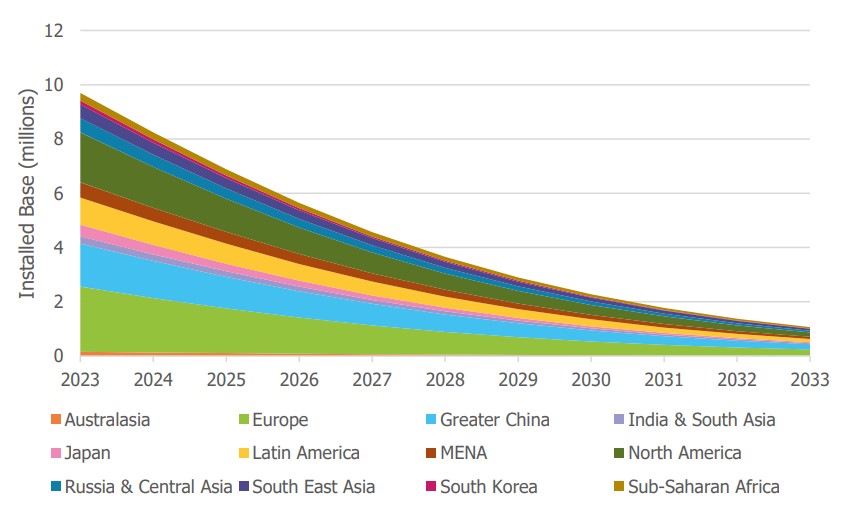This report provides Transforma Insights’ view on the In-Vehicle Navigation market. The In-Vehicle Navigation market includes applications used to navigate and provide routing to drivers. These applications have multiple features such as finding a specific location, determining the best route, real-time traffic updates, points of interest, offline map updates, and weather forecasts. In-vehicle navigation can be hosted on factory-fit vehicle head units or on dedicated aftermarket devices. Additionally, smartphones can also be used to access these applications, as they provide turn-by-turn navigation through apps such as Google Maps and Apple Maps that have increased competition for both navigation applications on vehicle head unit (embedded solutions) and aftermarket.
The report provides a detailed definition of the sector, analysis of market development and profiles of the key vendors in the space. It also provides a summary of the current status of adoption and Transforma Insights’ ten-year forecasts for the market. The forecasts include analysis of the number of IoT connections by geography, the technologies used and revenue.
A full set of forecast data, including country-level forecasts, sector breakdowns and public/private network splits, is available through the IoT Forecast tool.

The report examines the key factors that are influencing the development of the market, including:
This section of the report first charts some of the advanced functionalities in connected cars, argues that the ubiquity of connectivity has encouraged seamless use of such applications via the Vehicle Head Unit, and lists the benefits (like enhanced customer experience).
It then talks about the features of onboard navigation applications (such as finding a specific location) and highlights some of the features that are being offered by OEMs. For instance, BMW launched an AR video function for in-vehicle navigation across all BMW i4 models. The report then transitions to discussing aftermarket devices, providing a definition, and highlighting their distinctions from vehicle head unit navigation applications.
This section lists the major difference between vehicle head units and aftermarket devices (in the larger context of cost and monetisation opportunities). In a tabular format, it then discusses OEMs (including Audi, BMW, Ford, General Motors, Hyundai, Kia, Porsche, Tesla, and Toyota), their features, and subscription rates. For instance, Porsche’s Connect Navigation and Infotainment Package is free for the first twelve months and then, the organisation charges USD189 per year from users.
It also focuses on updates and collected user data as additional revenue generators. For instance, while maps are generally updated as a part of scheduled software updates for VHUs and aftermarket devices, in some cases, users may have to pay an additional charge (around USD200) for an update.
This part of the report enumerates and elucidates the key factors contributing towards the increasing adoption of navigation systems.
This subsection explains why in-vehicle navigation become crucial in electric vehicles (whose numbers surpassed 10 million in 2022). For instance, EV charging stations are unevenly distributed and have varying capabilities. In-vehicle navigation helps drivers find the most suitable and preferred charging stations for users.
This part explains how the increasing number of autonomous vehicles (which Transforma Insights estimates will reach 23.66 million by 2025) will also require navigation systems in some capacity.
This section charts and discusses the major factors that are slowing down the adoption of navigation solutions. Smartphones and the range of navigation apps they support are one of the major deterrents towards navigation solutions, due to reasons including low incremental costs of smartphones, regular updates of navigation apps (often with no associated cost for users), and more. It also explains how this has significantly declined the revenues of aftermarket providers like TomTom and Garmin. Besides, OEMs have struggled to convince users to use navigation applications on vehicle head units (a survey shows that 33% of users switched from navigation applications on vehicle head units to smartphones and aftermarket devices in less than two weeks), which has also affected the adoption of navigation solutions.
It also provides some examples of relevant IoT deployments in this application, including TomTom collaborating with Volvo cars for real-time map and traffic data updates and Ford modernising its Mustang Mach-E with cloud-based mapping.
The key vendors section lists some of the main providers of products and services related to the market such as TomTom, Garmin, Here Technologies, MiTAC International Corp., Audi, and Mercedes Benz. The report provides profiles of the various vendors including aspects most relevant to this Application Group, such as product offerings, pricing, financial results, and technology.
In the market forecasts section, we provide a summary of the forecasts from the Transforma Insights IoT Forecast Database:
The report charts the decline in the number of aftermarket connected devices (which will decline from 9.7 million in 2023 to 1.1 million in 2033). Transforma Insights forecasts are compiled on a country-by-country basis. This report includes a regional summary, showing splits between Australasia, Greater China, North America, Europe, Japan, Latin
America, MENA, Russia & Central Asia, South East Asia, South Korea, India & South Asia, and Sub-Saharan Africa.
Transforma Insights’ IoT forecasts include splits between the various connectivity technologies as follows: 2G, 3G, 4G, 5G mMTC, 5G non-mMTC, LPWA (non-mMTC), Satellite, Short Range, and Other.
This section discusses which technologies will be used in the In-Vehicle Navigation Application Group.
This part of the report discusses the market growth in terms of revenue (module revenue, service wrap revenue, and VAC revenue). Transforma Insights estimates that the revenue in the In-Vehicle Navigation Application Group will grow at a CAGR of 10%.